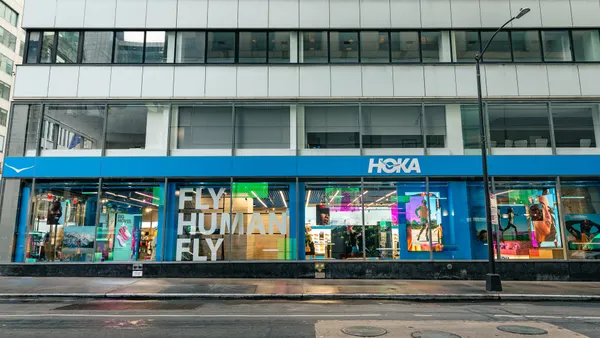UPDATE: May 2, 2019: The New York Stock Exchange on Wednesday notified Rite Aid that it has regained full compliance with NYSE minimum average share price listing requirements. The company, which has continued to trade on the exchange, was above the minimum requirement of a $1-per-share price, so is now in compliance with all NYSE listing rules, according to a Rite Aid press release.
Dive Brief:
-
Rite Aid's board of directors on Wednesday said it approved a reverse stock split of the retailer's common stock at a 1-for-20 ratio. Once effective (at market open April 22), that reduces the number of issued and outstanding common shares from about 1.08 billion to about 54 million and should boost the share price, to help ensure compliance with the New York Stock Exchange's share price listing rule, according to a company press release. The NYSE had warned the company is out of compliance, which can be regained if at the last trading day of any month during a six-month cure period (until July 3), the company has a minimum $1.00 share price and has maintained at least a $1.00 average closing price over the preceding 30 consecutive trading days.
-
On Thursday, the drugstore retailer reported a fourth quarter revenue decline to $5.38 billion from $5.39 billion in the prior year's fourth quarter. Retail Pharmacy Segment revenues reached $3.97 billion, flat compared to the prior-year period, while same-store sales from those continuing operations in the quarter rose 0.7%, consisting of a 2.1% increase in pharmacy sales and a 1.9% decrease in front-end sales, according to a company press release.
-
Net loss from continuing operations narrowed to $255.6 million from last year's net loss of $483.7 million, the company also said. That improvement in operating results was due primarily to a goodwill impairment from the prior year and lower income taxes.
Dive Insight:
Rite Aid is resorting to financial levers as it works to adjust to operating as a slimmed down company facing robust rivals.
The drugstore has faltered as Walgreens and CVS have moved assertively into medical care and even performed better at the front of the store, despite spotty retail operations in most locations. CVS recently upped the ante by expanding same-day delivery of prescriptions to 6,000 stores across the U.S., an option that customers can also use for over-the-counter and household goods.
Rite Aid's latest report included the retailer lowering its outlook for fiscal 2020, with an expectation of sales to reach between $21.5 billion and $21.9 billion, same-store sales to range from flat to a 1% year-over-year increase and net loss to land between $170 million and $220 million.
"Rite Aid's weak quarterly results and lower guidance are consistent with our view that top line growth and margin improvement will be difficult to achieve for the company in 2019 as reimbursement pressures will persist," Moody's Investors Service Vice President Mickey Chadha wrote in comments emailed to Retail Dive. "Rite Aid's small scale vis-a-vis it's competitors will also remain a disadvantage as size becomes increasingly important to gain script volume, new PBM contracts and cost efficiencies."
The company is operating in a retail segment that is heavily dependent on surging costs in prescription drugs and medical services. Pharmacy sales in the fourth quarter, for example, "were negatively impacted by approximately 100 basis points as a result of new generic introductions," the company said. But Rite Aid is ill-equipped to compete effectively in other departments.
While the drugstore sector continues to lag behind beauty specialty retailers in terms of innovation and customer experience, for example, Walgreens and CVS have managed to grab much of that market, according to Edge by Ascential's recent Health, Beauty and Personal Care report. Walgreens and CVS contributed 64% of the top 10 specialists' health and beauty sales in 2018 and "are also driving innovation in the health & beauty sector through introducing more in-store digital solutions and services," according to that report, which was emailed to Retail Dive.
Its focus may be elsewhere, as the company awaits a new chief executive. Last month, Rite Aid announced it's cutting about 400 full-time positions, or more than 20% of the corporate positions at its headquarters and across the field organization, along with several changes in top management, starting with CEO John Standley stepping down.
Those moves are drastic (and will entail a one-time restructuring charge of about $38 million, the company said) and reflect Rite Aid's smaller footprint after it sold stores to Walgreens and closed others. The savings will "offset an expected reduction in income" related to Rite Aid's sale of some 2,000 stores to its rival after the two failed to merge in 2017.














